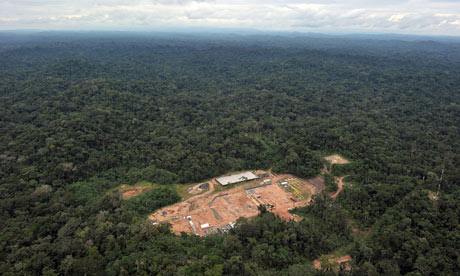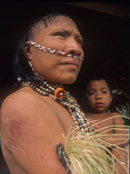Gas company targets protected Manú park in Peruvian Amazon
Leaked document reveals Pluspetrol is eyeing a region where biodiversity 'exceeds that of any other place on Earth'

Pluspetrol's Pagoreni-B gas well, part of the Camisea project in the Amazon jungle near Cuzco, Peru. Photograph: Cris Bouroncle/AFP
An energy company is eyeing up the gas reserves of a national park in the Peruvian Amazon whose biodiversity Unesco says "exceeds that of any other place on Earth" and is home to indigenous people who have no regular contact with the outside world, a leaked document seen by the Guardian shows.
The revelation about Manú national park follows rumours and reports circulating in Peru that the government will create a gas concession bordering or including parts of the park, but which have not been publicly confirmed.
The document, Research Plan for Geological Exploration and Surface Geochemistry in the Manú National Park and its Buffer Zone, was written by Lima-based consultancy Quartz Services for company Pluspetrol, which operates an existing gas concession in the region, Lot 88, known as the Camisea project.
"It's shocking. This is the first time we've seen evidence for plans to expand hydrocarbon activities into Manú," said anthropologist Daniel Rodriguez, who has worked with Peruvian indigenous federation Fenamad for years. Chitonahua tribe member. Photograph: Glenn Shepard
Chitonahua tribe member. Photograph: Glenn Shepard
 Chitonahua tribe member. Photograph: Glenn Shepard
Chitonahua tribe member. Photograph: Glenn Shepard
"This proves what conservationists and indigenous rights activists have long suspected, but which petrochemical representatives and Peruvian officials have concealed or outright denied: that there are gas and oil deposits in Manú national park," said anthropologist Glenn Shepard.
Manú is home to 10% of the world's bird species, 5% of all mammals and 15% of all butterflies, as well as rare animals like jaguars and giant armadillos. Unesco has declared the park a World Heritage Site and biosphere reserve, and says it is more biodiverse than any other place on the planet.
"Manú is probably the most biodiverse protected area on the planet," agreed Rob Williams from the Frankfurt Zoological Society. "Madidi in Bolivia is the only likely competitor."
"It's terrifying to think that Pluspetrol has been planning this," said Rebecca Spooner, a researcher at Survival International. "How can any company justify working in such a sensitive region?"
Peruvian law prohibits extractive operations in national parks. According to Quartz's document, dated March 2012, Pluspetrol has applied for and been denied permission from Peru's protected areas authority to enter the region, but Quartz could develop a strategy to obtain such permission in the future.
"Our mission, as an institution providing specialist technical services to Pluspetrol, will be to contribute not only to the continuation of activities in Lot 88, but also to the development of the Manú National Park protected area," reads the document. "Pluspetrol has plans to do geological exploration in the River Maquizapango region and/or its surroundings, an area to the east of the Lot (88) and inside the Manú National Park."
Quartz's manager, Efren Tomaylla, confirmed the document had been prepared at Pluspetrol's request and submitted to it, but said Quartz had not heard back.
One anthropologist told the Guardian under condition of anonymity that Quartz's plans, if put into practice, would seriously endanger people in Manú.
"It says it will do 'a direct study of human cultures', but doesn't say who exactly that would involve," said the anthropologist. "Even settled communities in Manú contacted 50 years ago remain extremely vulnerable to any kind of illness."
Pluspetrol refused to comment.
No hay comentarios:
Publicar un comentario